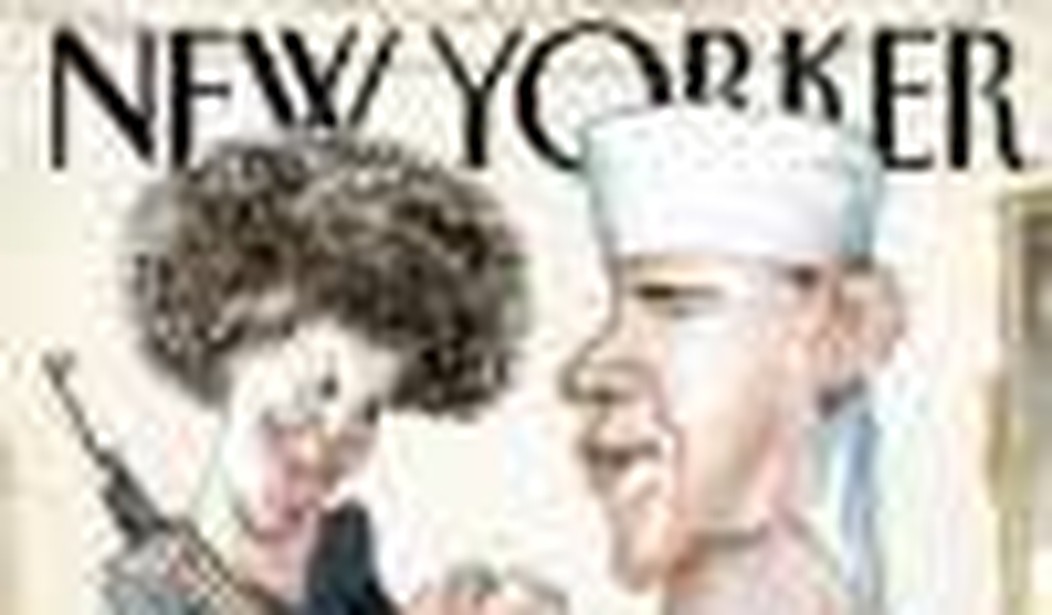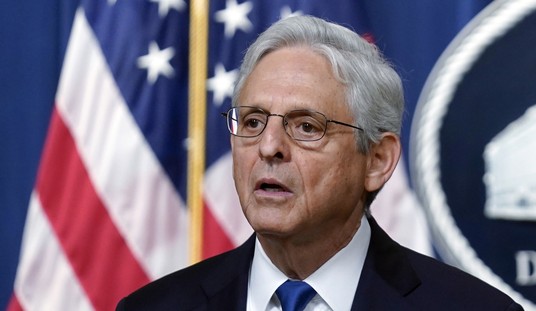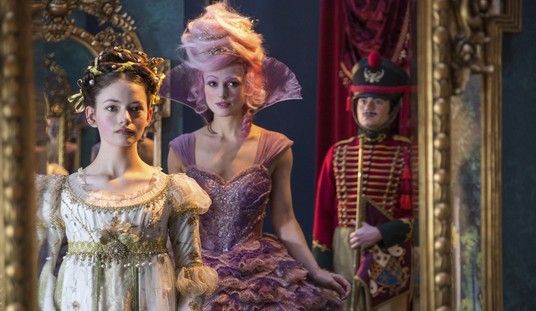Listening to the chorus of fainthearted responses to this week’s New Yorker cover, one gets the impression that satire, like everything else in our sad culture, must now come with a warning label and child-safety latch. Barry Blitt’s slightly overwrought but still amusing illustration, which is even pedantically titled “The Politics of Fear,” features the Obamas fist-bumping in the Oval Office. Michelle is rendered as an AK-47-wielding Angela Davis, Barack is tricked out as a pious Muslim, an Osama Bin Laden portrait hangs on the wall and an American flag burns in the fireplace.
Irony should cut like a rapier, not drop like a Steinway, but still, it’s not hard to appreciate what this pictorial intends. Yet it has got a few supporters of the Illinois senator barking mad.
Obama himself had no direct response to the cover, presumably because the task of appearing dull-witted and earnest fell to his campaign spokesman Bill Burton, who said: “Most readers will see it as tasteless and offensive. And we agree.” How Mr. Burton presumes to know what most readers will think is a question for another day, but the McCain camp, likely fearing any other interpretation might be seen as darkly motivated, swooped in to second his artistic criticism.
Some outraged liberals have gone so far as to cancel their subscriptions to the New Yorker — or at least claim that’s what they’ve done until Seymour Hersh announces next month that the Pentagon already bombed Iran over the 4th of July — while others are quick to insist they “get” the joke but still fear the reactionary hysterics and illiterate rubes it lampoons will not.
Eve Fairbanks at the New Republic is a particularly sensitive minder of low IQs. The Blitt pic, she says, is “no better than Perry Bacon’s infamous Washington Post story, ‘Foes Use Obama’s Muslim Ties to Fuel Rumors About Him.’ Both outlets claimed not to support the allegations they were visually or rhetorically putting forward — obviously! — and yet a reader would have to have a fairly sophisticated understanding of each outlet’s ethos to immediately intuit the intended ironic distance.”
Is Ms. Fairbanks suggesting that the “ethos” of the Washington Post and the New Yorker is liberalism or sanity? Obama himself issued several press statements combating the same email-circulated rumors the newspaper felt obliged to address. It would have looked defensive and guilty — qualities that could have easily been extrapolated as partisan bias by the same point-missing nincompoops Fairbanks worries about — to slap disclaimers on its own reporting. Even a few conspiracy theorists can distinguish news from editorial content.
Evidently, though, context in any medium should be taped off and advertised with bright orange cones. One umbrageous reader of Andrew Sullivan’s blog writes:
The New Yorker might just as well put in a drawing of Obama planting watermelons in the rose garden. Yes satire. But also an image we don’t want out of a careful context. Spike Lee even in his piece of genius “Bamboozled”, felt compelled to preface the film with Webster’s definition for the word “satire”, and with film, it’s much easier to keep the context and tone of its content clear. The people who read the New Yorker understand what it is. But we all know these things escape their audience and context and take on a life of their own too.
There’s every chance that a benighted hick averse to reading dictionary definitions on film screens wandered into a showing of Bamboozled and came away with all the wrong conclusions. (There’s also the chance that a humorous civil rights activist thought Spike Lee’s film was no good.) A basic rule of satire is that if you have to explain your point, even a little bit, you’ve already failed. Imagine Evelyn Waugh prefacing Decline and Fall with a preemptive apology to the English public school system and the Welsh, or Mark Twain introducing “Some Thoughts on the Science of Onanism” with a few lines on what he really thought about hand-jobs. How might one master of the essay be considered by posterity had these chilling words ever appeared in print: Mr. Swift does not actually advocate the eating of Irish infants?
It’s a pity that New Yorker editor David Remnick capitulated so easily to philistines and spelled out the following exegesis to the Huffington Post: “What I think [the cover] does is hold up a mirror to the prejudice and dark imaginings about Barack Obama’s — both Obamas’ — past, and their politics.” And to think we missed a potted lesson in the joys of post-Crown Heights multiculturalism after Art Spiegelman conceived of a black-hatted Hasid kissing a black woman.
A less observed rule of satire concerns its inevitable consequences. No amount of explanation will ensure that the joke won’t still be misconstrued or misunderstood by those destined by cruel nature to do just that. What are the odds that the number of voters who think that the “real” Barack Obama belongs in a Gitmo detention cell has increased since this latest issue of the New Yorker hit newsstands? Anyone who could be converted to those feverish ranks by a mere caricature is going to cause electoral trouble anyway.
We saw with bloody effect, in the aftermath of the Danish cartoon mess, that some audiences are born thick and crude, and that the only sure way to prevent giving “offense” to them is not to do or say anything, anytime, anywhere. It was argued then by correct-thinking types who claim to be on the side of art and literature and free expression that those cartoonists were right-wing bigots who needlessly provoked their own attempted murders. Now a highbrow liberal weekly in the United States is being assailed by the bien-pensant because it failed to dumb down its characteristically mordant daubing.
So much for the idea that sophistication is moored to progressive politics.









Join the conversation as a VIP Member